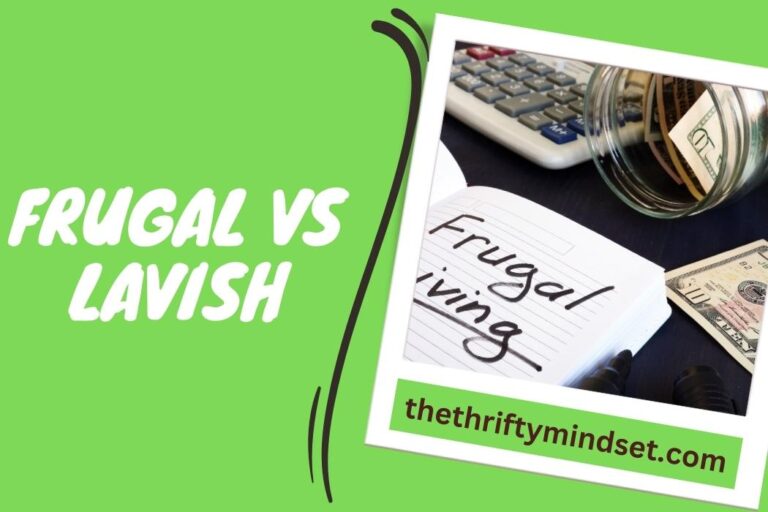In the vast spectrum of lifestyles, two contrasting philosophies emerge frugality and lavishness. While frugality champions the art of maximizing value with minimal resources, lavishness celebrates abundance, often without bounds.
But it’s not just about money. It’s about choices, values, and the underlying motives that drive us. Do we seek simplicity, finding joy in the little things, or do we yearn for opulence, measuring success by the grandeur of our possessions?
As we dive into this subject, we’ll uncover the subtle differences that set each approach apart.
We’ll also see how society views them and feel the deep influence they cast on our everyday lives. Dive in, and let’s unravel the intricate dance between living frugally and indulging lavishly.
Frugal vs. Lavish: A Comprehensive Comparison
1. Definition
Frugal:
Meaning: Living frugally means being economical and avoiding unnecessary expenditures. It’s about maximizing value and minimizing waste.
Tip: Frugality doesn’t mean being cheap; it’s about making thoughtful choices.
Lavish:

Meaning: A lavish lifestyle is characterized by extravagance and luxury. It often involves spending without restraint.
Note: Lavishness can be seen as a sign of wealth but may lead to financial instability if not managed properly.
2. Spending Habits
Frugal Spending:
Budgeting: Careful planning and sticking to a budget.
Prioritizing Needs: Focuses on necessities over wants.
Savings: Often leads to higher savings and financial security.
Stats: According to the “Rich Habits” study conducted by Tom Corley, frugal individuals save an average of 20% more than others.
Lavish Spending:
Impulsive Buying: Tendency to make large, unplanned purchases.
Luxury Items: Preference for high-end brands and products.
Potential Debt: This may lead to financial strain or debt.
Note: It’s essential to balance enjoyment with financial responsibility.
3. Savings and Investments

Frugal Approach:
Savings: Prioritizes building an emergency fund and saving for future needs.
Investments: Often leans towards conservative investments, focusing on long-term growth.
Tip: Regularly reviewing and adjusting one’s financial portfolio can optimize returns.
Lavish Approach:
Savings: May have limited savings due to higher expenditure.
Investments: Might lean towards high-risk, high-reward ventures.
Note: It’s essential to diversify investments to mitigate potential risks.
4. Social Perception
Frugal:
Viewed As: Prudent, wise, and sometimes overly cautious.
Misconceptions: Might be mistaken for being stingy or lacking ambition.
Lavish:
Viewed As: Affluent, successful, but potentially wasteful.
Misconceptions: Can be perceived as show-offs or financially irresponsible.
Unique Insight: Social status can sometimes overshadow genuine character in lavish circles.
5. Long-term Financial Health
Frugal Choices:
Stability: A greater likelihood of financial security and freedom.
Debt: Lower chances of accumulating significant debt.
Expertise Insight: Frugality can be a stepping stone to achieving financial milestones like homeownership or early retirement.
Lavish Choices:
Stability: Potential for financial strain if expenditures outpace income.
Debt: Higher risk of debt due to luxury purchases and lifestyle maintenance.
Tip: Regular financial check-ups can help maintain a balance between luxury and sustainability.
6. Environmental Impact
Frugal:
Eco-Friendly: Tends to favor sustainable and minimalistic choices, reducing waste.
Carbon Footprint: Generally lower due to reduced consumption.
Note: Buying quality over quantity can further reduce environmental impact.
Lavish:
Eco-Friendly: Might have a larger carbon footprint due to luxury travel and products.
Consumption: Higher consumption can lead to more waste.
Unique List: Some eco-luxury trends include electric sports cars, sustainable fashion, and green architecture.
7. Value Perception
Frugal Mindset:
Value: Sees worth in terms of utility, longevity, and necessity.
Purchases: Often researches extensively before buying to ensure maximum value for money.
Tip: Embracing a minimalist mindset can enhance the appreciation of true value.
Lavish Mindset:
Value: Associates worth with brand names, luxury, and exclusivity.
Purchases: Might buy for the prestige or the experience rather than just the utility.
Note: While luxury items can offer superior quality, it’s essential to discern between genuine value and mere brand appeal.
8. Travel Preferences
Frugal Traveler:
Destinations: Prefers budget-friendly locations or off-the-beaten-path experiences.
Accommodations: Likely to choose affordable lodgings, such as hostels or budget hotels.
Unique Insight: Traveling during off-peak seasons can offer both savings and a more authentic experience.
Lavish Traveler:
Destinations: Gravitates towards exotic, high-end locales.
Accommodations: Prefers luxury hotels, resorts, or even private villas.
Tip: Leveraging loyalty programs and credit card points can enhance the luxury travel experience.
9. Wardrobe Choices

Frugal Fashion:
Clothing: Prioritizes quality over quantity, often opting for classic pieces that last.
Shopping: Waits for sales, discounts, or thrift stores to get the best deals.
Note: A capsule wardrobe can be both stylish and economical, reducing the need for frequent shopping.
Lavish Fashion:
Clothing: Emphasizes designer labels, current trends, and exclusivity.
Shopping: Might indulge in frequent shopping sprees, especially during new season releases.
Unique List: Some luxury fashion trends include bespoke tailoring, limited-edition releases, and haute couture.
10. Dining Habits
Frugal Dining:
Eating Out: Prefers local eateries, food trucks, or places offering good value.
Home Cooking: Likely to prepare meals at home, experimenting with diverse cuisines on a budget.
Tip: Meal planning can reduce food waste and ensure a balanced diet without breaking the bank.
Lavish Dining:
Eating Out: Enjoys fine dining, gourmet restaurants, and exclusive culinary experiences.
Home Cooking: Might hire personal chefs or order gourmet meal kits.
Stats: According to a study by PopMenu, high-end diners spend an average of 40% more on dining experiences than the average consumer.
Final Thoughts
While both frugal and lavish lifestyles have been dissected across various facets of life, one unique aspect remains personal identity. Our choices, whether frugal or lavish, often reflect our inner values, aspirations, and societal influences.
Frugality emphasizes sustainability, value, and long-term contentment, while lavishness celebrates luxury, prestige, and immediate gratification. At the heart of it, the real debate isn’t about which way of life is better. It’s more about what fits seamlessly with one’s own life story and aspirations.
I’m Grayson Watson, your frugal companion and the brain behind this money-saving extravaganza. Strap yourself in, because we’re about to embark on a wallet-friendly adventure like no other. Learn More!

